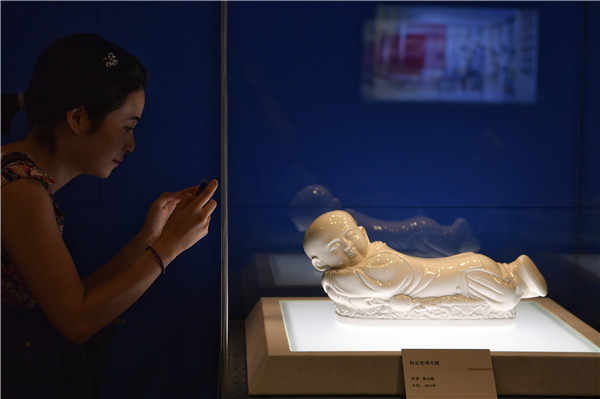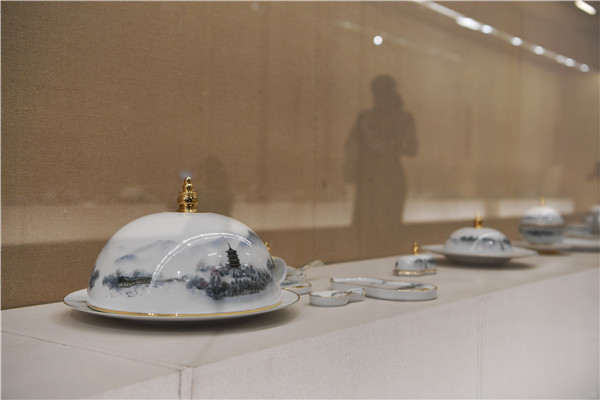Information
Porcelain for posterity
 |
A copy of the Ding ceramic pillow by the late artist Chen Wenzeng, featuring a baby boy is on show at the National Museum of China. [Photo by Jiang Dong/China Daily] |
An ongoing exhibition in Beijing showcases the excellence of the 'five great kilns' of imperial China. Lin Qi reports.
Some 40 years ago, the late Chen Wenzeng became an artisan at a porcelain-making factory in his native Hebei province. There he met two workers, Lin Zhanxian and He Huan. The three of them then devoted themselves to restoring the glory of Ding ware.
For many centuries, between the Tang (618-907) and Yuan (1271-1368) dynasties, kilns in Hebei's Dingzhou county, now called Quyang, where Chen was born, produced white ceramics, making the Ding kilns one of ancient China's "five great kilns".
The technique, however, declined and disappeared in chaos after Yuan rule ended.
Relying on scanty historical records, the trio then revived the technique of making Ding ware.
Their reproductions show how a Ding ceramic is unique with its paper-thin body, its smooth texture and sound, which resembles that of the ancient Chinese percussion instrument qing.
As for Chen, one of his celebrated works is a copy of Northern Song Dynasty (960-1127) pillow. It is molded in the shape of a baby that lies on its belly, and its back is where people rest their heads.
There are three original ceramic pieces in existence in China: one housed at the Palace Museum in Beijing and the other two are at Taipei's Palace Museum.
Meanwhile, before he died in 2016, Chen donated one of his pieces (copies) to Beijing's Palace Museum and an identical work to the National Museum of China. The latter is now on show at an exhibition of the National Museum of China's recent acquisitions of modern porcelain pieces.
 |
Exhibits include sets of dinnerware used as state gifts and at official gatherings. [Photo by Jiang Dong/China Daily] |
The exhibition showcases works that celebrate the excellence of the "five great kilns" in the Song Dynasty-the Jun, Ru, Guan, Ding and Ge kilnsand as well as pieces representing the Longquan kilns.
Besides the works from the kilns there are copies of other classic ware from the state museums, including a Song vase modeled after zun, a kind of bronze ware.
The original piece is in Shanghai Museum, and the piece on display was produced last year by Wang Jianwei, 52, from Henan province.
There are also works from the Heavenly Clothes painting series by Sun Jun, which depict the elegance and lightness of clothes blowing up by wind.
Lyu Zhangshen, director of the National Museum of China, says the exhibition showcases the artistic heights of Chinese porcelain, and the efforts of today's artists in carrying forward these traditions.
He says the ceramics fired at the five great kilns were exported to West Asia and Africa via the ancient marine Silk Road as early as the Tang Dynasty and through the Yuan Dynasty, and after the late 14th century they were sought by European royalty.
"Chinese porcelain had cast an influence on the economy, technology, culture and daily life of different regions," he says.
He says, however, that later the country suffered a sharp decline in the porcelain industry because of social turbulence and underdeveloped production capacity, not to mention global competition. He says many of the artists featured at the exhibition are among the first-generation from State-owned factories, which were established between the 1950s and 1970s.
The factories were mostly located at the former sites of the "five great kilns", and they sought to revive dying techniques.
Lyu says that these factories, which operate today, have not only decoded the secrets of porcelain-making but have also created modern works, especially Chinese-style dinnerware that are used as state gifts and at state feasts.
The exhibition also features tableware, which was used at the G20 summit held in Hangzhouin 2016 and at the Belt and Road forum in Beijing in May.
The tableware was designed and manufactured in Zhejiang province-where the Longquan kilns and the Ge kilns were located-and in Shenzhen.
Zhang Shouzhi, a retired professor of Tsinghua University who specializes in porcelain technique, says that to rebuild China's reputation in porcelain, Chinese companies have to study classic Chinese motifs and shapes.
The 85-year-old veteran, who has designed ceramic sets used for state ceremonies since the 1950s, says: "The main thing for a ceramic artist is to love life. For example, Longquan boasts picturesque scenery and people turned their love for the landscapes into Longquan green-glazed porcelain."
Contact the writer at linqi@chinadaily.com.cn
If you go
9 am-5 pm, through July 30. 16 East Chang'an Avenue, Dongcheng district, Beijing. 010-6511-6400.
Category: English
News
Information
Key words:
